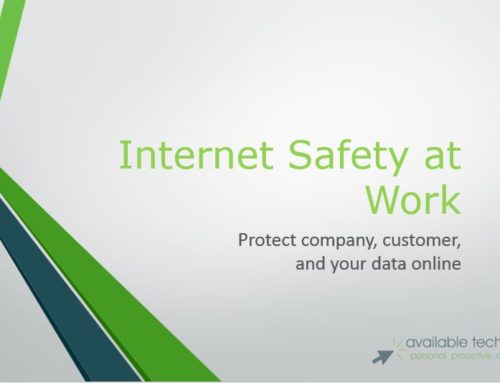Protecting Your Digital Identity
We get used to technology changing at a rapid pace, and sometimes you don’t notice how things have changed until you step back and realize how dependent we are on our computers. The prolific use of the Internet is probably the most significant change in technology we have experienced (or will experience) in our lifetime.
We use the internet for everything. It is used to pay bills, reconcile our bank accounts, pay quarterly taxes and do our Christmas shopping. Cell phones deliver messages to us at the moment they are sent. There can be no disputing that email use has revolutionized communications in business. We are truly a “connected” society.
The problem is that we are all indeed connected. Those of us who would normally not come into contact with certain less-desirable elements of society are now thrown into the collective melting pot that is “the internet.” And just like all societal groups, that by their nature largely follow the rules and mean no harm, there are predators there.
Everytime you pay a bill or sign up for a coupon or newsletter, a piece of your information is being submitted to a potentially unsafe source. Online banking and shopping put credit card numbers and vital security info on a database server that could be hacked by electronic criminals. Even our medical information is kept in a digital format, with the possibility of dissemination to the wrong element in our collective internet community.
To exclude ourselves from the internet and it’s advantages, both personal and professional, is to some degree an irresponsible squandering of opportunities to enrich your own life and the lives of others.
Fortunately, you can take steps to protect yourself and become a less likely target for identity theft.
How Big of A Problem is It?
Everyone is taking notice, and most are concerned. The Federal Trade Commission estimates that up to 9 million Americans were victimized in this way last year. Identity theft costs victims hundreds if not thousands of dollars, and months or years of agonizing struggle to sort out the instances of fraud.
One of our own clients had their company’s information used to take out a business loan. When the loan was defaulted on, the company began receiving calls to collect the bad debt. The company is still spending time and money to straighten out the aftermath of the identity theft.
How Does it Happen?
Identity thieves are looking for such information as your name, social security number, credit card numbers, birth date and so on. Once found, this information is used to make purchases or commit crimes, or the information is sold to others who will do so.
These attacks occur primarily in two forms: Phishing and Keylogging.
Phishing
“Phishing” is a term coined by computer hackers, who use email to fish the Internet hoping to hook you into giving them your logins, passwords and/or credit card information. In all these scams, the phisher first impersonates a legitimate company such as your own internet service provider, or your auction site or a financial institution. In the typical scam, you’ll get an email that appears to be from a reputable company. You’ll be asked to go to a special site to update your account information. This is usually a “red flag” because a reputable business should NEVER ask you to update personal account information in an email!
If you get one of these messages, don’t panic – and don’t respond. Remember this advice: Don’t give your personal information to anyone you don’t know. If you are concerned that the message might be genuine, call your ISP (or bank or other organization being spoofed) at a telephone number you obtain from your billing statement or through an email address the legitimate company provides.
Keyloggers
do not search for your personal information on your computer but literally do what the name suggests – log the keys that you press on the keyboard. Once the virus makes a record of every keystroke you enter, the information can be used to find out login names, sites you have visited, credit card numbers and passwords. Keyloggers are normally spread by viruses in downloads or emails and can also be added as attachments in advertising or spam. Howver, they could also be planted by someone with physical access to your computer. Since they are designed for stealth, keyloggers are typically hard to detect. Updated virus protection like ESET NOD32 will catch these programs before they can set up shop on your PC.
————————————————————————
Protecting Yourself from Identity Theft
For both Keyloggers and Phishing scams, follow these tips:
Consider using a keyscrambler. The most popular of these is called – you guessed it – Keyscrambler. The free version of Keyscrambler encrypts each keystroke you enter to feed false information to any keyloggers that may be on your system. Google “keyscrambler” to find out more.
Look for the Lock. Be sure that any transaction which requires you to enter sensitive information is done so in a secure environment. The lock icon on the status bar at the bottom of your browser indicates that the site you are currently viewing is encrypted, meaning that the site publisher has been verified to be who they say they are and that communication is secure.
Also, don’t enter credit cards or other information in to a site unless the site address is shown as “HTTPS” rather than “HTTP” in the address bar. This ensures that data can’t be read if it is intercepted.
Updates and Antivirus. Be sure you have a good (i.e. not free) antivirus program and keep it updated. We Recommend ESET NOD32 Antivirus and have used it for years.
In addition, virus writers typically look for security flaws in your computer’s operating system and exploit them. Microsoft and others are constantly looking to repair those flaws so that hackers and virus writers are not able to get through. They do this by providing security updates that you can download and install from the Internet. Update your operating system to close these security holes.
———————————————————————–
General Internet Security Tips
Use unique passwords and keep them in memory, not on paper. Believe it or not, “passsword” or “secret” are not good passwords. A strong password has capital letters, numbers, and non standard characters like punctuation to makeit much more difficult to guess.
Don’t enter passwords or other sensitive info in an email. Email is sent as clear text, and is the easiest of data to intercept, especially over a wireless network.
———————————————————————–
For information on any of the information in this month’s newsletter, please call Available Technology at 864.232.1234 https://available-tech.net





